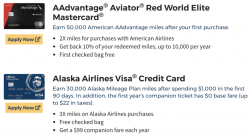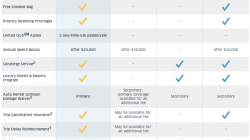I wrote a post yesterday describing several reasons NOT to get a United Airlines credit card — although there may still be reasons for some people to get one based on their individual travel situations and predilection for manufactured spend. (If you’re going through $20,000 a week, then you should probably get every single card that offers an annual spend bonus.)
A few readers asked what I thought about legacy United cards or if I recommend other cards instead of a United card. I’ll cover the first question today and the other in a later post.
The Case for Presidential Plus
There are really only two legacy cards that I think bear mentioning because they have good benefits and many people still carry them. The first is the Presidential Plus card from the pm-CO side. Its benefits are nearly identical to the current MileagePlus Club card, including a lounge membership, 2X on United purchases, two free checked bags, and no foreign transaction fees.
One reader mentioned he can renew this card with an annual fee of only $79 because he already has a lifetime United Club membership and wanted to know if he should keep it. A lower annual fee isn’t reason enough. I could advertise something at $395, mark it down to $79, and you still shouldn’t pay for it unless you’re getting something of value.
To this reader, I would say it might be worth it if you use one or more of the following benefits:
- Free checked baggage (but most people carry on)
- Priority Access (but you probably have elite status if you have a lifetime lounge membership)
- Avis President’s Club membership (but maybe you favor a different rental agency)
I don’t recommend keeping this card for most of the other benefits. The Hyatt Platinum membership can be obtained with a less expensive $75 annual fee from the Hyatt Visa card — though for a $4 difference it’s okay to keep what you have. The Presidential Plus card offers a 2X bonus on purchases from United, hotels, and car rentals, but you can get these same bonuses from the Sapphire Preferred. The Hyatt Visa also offers a 2X bonus on restaurants, car rentals, and airfare — but only 1X at other hotels.
In fact, the only real value I see in this card is the ability to earn Flex PQMs at the rate of 1,000 for every $5,000 spent. These allow you to top up your Premier Qualifying Miles balance each year of your choosing to get you to the next elite tier. However, keep in mind they can only help you earn up to the Premier Platinum level. Flex PQMs do not count toward Premier 1K status in any way. Even if you redeemed 75,000 Flex PQMs, you would still need 100,000 traditional PQMs — not the difference of 25,000 — to get Premier 1K status. Never redeem Flex PQMs if you think you’ll earn 75,000 or more PQMs without them.
Flex PQMs are unique enough that they’re worth holding onto this card as long as you value the lounge access even if you’re not getting the great $79 rate offered to the reader in question.
Some people have built up a sizeable balance of Flex PQMs, but you have to be satisfied with Platinum status to use them. I don’t see a particular problem with this. Platinum members still get many of the fee waivers offered to 1K members, and the only significant difference for 1K members is better upgrades. Even if you have and want to keep Premier 1K status right now, it might be worth keeping this card to give yourself a soft landing to Platinum in the future.
The Case for MileagePlus Select
The second legacy card that offers value is the MileagePlus Select card, which I used to carry until recently. It offers 3X on United purchases; 2X on other Star Alliance purchases; and 2X on gas, grocery, and home improvement purchases.
I think it’s great that this card recognizes United is a member of an airline alliance. So many airline credit cards only offer a bonus for purchases from the co-branded carrier. United certainly attempts to discourage purchases from other airlines under its new scheme for earning PQDs, which must either have a United flight number or be issued by United to get credit. You can get a waiver from this requirement if you spend $25,000 on this or other Chase-issued United cards.
But let’s say you aren’t going to get a waiver and you aren’t going to earn enough PQDs for elite status. You might still want to fly United or its partners.
When United announced new rules for issuing award miles (not elite qualifying miles) based on the ticket price, it said that you could still earn award miles based on the distance flown if your ticket is on a partner and NOT issued by United. In other words, those flights that do not earn PQDs can still earn distance-based award miles. Some people may do quite a bit of international travel on discounted fares and find themselves in this interesting sweet spot. It lets you potentially earn more award miles with distance-based rules.
In this case, it might make sense to keep the MileagePlus Select card. If you book with United, you’ll get 3X on purchases but be forced into revenue-based award miles. I suppose that larger multiplier could make up for some of the decrease in miles earned (if any) through a revenue-based program. And if you book with a partner, you’ll get a 2X bonus. You could replicate with another card like the Sapphire Preferred or Hyatt Visa, but maybe you do a mix of United and other Star Alliance purchases and don’t want to deal with a second card.
The answer is not very clear for this one. I think the MileagePlus Select card continues to be better than the newer MileagePlus Explorer, but that’s not a very compelling statement.
Update: A comment below mentioned I forgot the opportunity to earn up to 5,000 PQM on your first $5,000 of United ticket purchases with the MileagePlus Select card. My excuse is that I see this card as an opportunity to earn bonus award miles. In light of recent changes I think it has become much more of an issue that people earn sufficient PQDs and that PQMs will follow easily. The value of up to 5,000 PQMs becomes more important if you manage to spend $25,000 (on all purchases) and obtain a PQD waiver.






